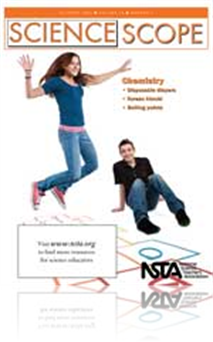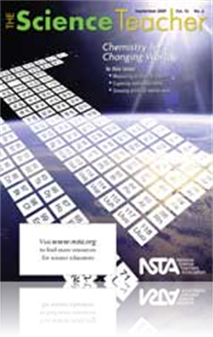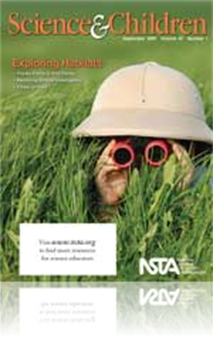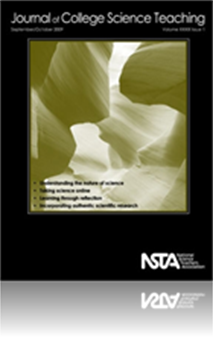All Resources
Journal Article
"New Science" and Societal Issues
As a “new science,” nanotechnology has brought many nanoscale-based applications to the forefront of society. This article describes one such application—a nanosensor that can precisely detect a variety of chemical stimuli in the environment�...
Journal Article
Everyday Engineering: What makes a squirt gun squirt?
You may not think of engineering and squirt guns in the same sentence. However, like many examples of engineering design, the squirt gun pump mechanism is uncomplicated, yet elegant, and very inexpensive to manufacture. The design is widely used beca...
Journal Article
“Why would a deer print be in the city?” wondered a student. She had noticed the track near a grocery store that morning with her mother. She was familiar with deer and had noticed their prints on a trip to a local museum; however, she had never ...
Journal Article
Science Sampler: Chemistry in action—Triple delight
Melt away the winter blues with this series of chemistry investigations. Here the author describes how she capitalizes on students’ love for snow days, bubble gum, and ice cream to reinforce what they have learned about percentage concentration of ...
Journal Article
Career of the Month: An Interview With Science Writer Tina Saey
The term science writer describes a range of careers. Some science writers author books. Others work for colleges, universities, or businesses and communicate research underway at those institutions. Some help scientists compose grant applications fo...
Journal Article
Scope on the Skies: October Skies (2009)
Our Sun is an incredible fusion machine that has been churning out energy for approximately five billion years. In another five billion years, when the internal temperature of the star begins to change, the balance between the thermal pressure pushin...
Journal Article
Labels such as “low-fat” and “trans-fat free” are seen on food products everywhere, and yet most of my students do not know what these terms really mean. Can you help me?...
Journal Article
Science Sampler: Enhancing student understanding of physical and chemical changes
Students within the Findlay, Ohio, City School District, as well as students across the country, struggle with understanding physical and chemical changes. Therefore, in this article, the authors suggest some standards-based activities to clarify mis...
Journal Article
Editor’s Corner: Science in Society
There are many important reasons for students to learn science. It prepares them, as the next generation of workers, for careers in the ever-expanding science, technology, engineering, and mathematics (STEM) fields. It also enables them to understand...
Journal Article
The circles and patterns in a tree’s stem tell a story, but that story can be a mystery. Interpreting the story of tree rings provides a way to heighten the natural curiosity of students and help them gain insight into the interaction of elements i...
Journal Article
Editor’s Roundtable: Chemistry beyond the chemicals
Middle level teachers need to show students that chemistry is not just about blowing things up or memorizing the periodic table of elements. We should help them see that chemistry involves living organisms as well as nonliving objects and is much mor...
Journal Article
Socratic Seminars in Science Class
Discussions are important classroom tools—and those that focus on science in society have the potential to interest and engage students. However, a conversation can quickly veer out of control if expectations are not clearly set by the teacher and ...
Journal Article
Science Shorts: Astronomies of Scale
Astronomical scale is a difficult concept for elementary students to grasp when they begin studying the solar system. A school yard solar system model gives students a tangible experience of astronomical distances. After determining the distances bet...
Journal Article
Connecting science with different cultures is one way to interest students in science, to relate science to their lives, and at the same time to broaden their horizons in a variety of ways. In the lesson described here, students make kimchi, a delici...
Journal Article
The Prepared Practitioner: Historical Perspectives
In the June 2009 issue of Phi Delta Kappan, author Noah Feinstein argues that a discrepancy exists between society’s stated goal—that science education prepare all citizens for the future—and the reality, which is oriented toward creating a sci...
Book Chapter
Is It Possible to Turn Coal Into Diamonds?
How cool would it be to be Lois Lane? Anytime she wants a diamond, she just has Superman use his super strength to squeeze a lump of coal. But is this really possible? Using a high enough temperature and enough pressure, can you turn coal into diamo...
Journal Article
Idea Bank: Wiffle Ball Physics
Projectile motion, a cornerstone topic of introductory physics, is usually a student’s first exposure to the problem-solving techniques used in this subject. Often, this is an inactive learning experience—students work with pencil and paper to re...
Journal Article
Science Sampler: Helping students write scientific explanations
Constructing explanations is an important scientific practice that brings meaning to all that scientists do. But just because it’s important to scientists doesn’t mean it’s going to be important to students. However, getting students to engage ...
Journal Article
Science Sampler: Getting into the habit of persistence
Habits of mind are the behaviors commonly exhibited by successful people when the solution to a problem is not immediately evident (Costa and Kallick 1992). In a science classroom, persistent students stop and think about a problem they encounter bef...
Journal Article
Becoming Wildlife Investigators
Students love learning outdoors, but how do you ensure they are absorbing the science and gaining skills as they do so? The authors found a way—a fourth-grade classroom teacher, a gifted/science resource teacher, and a group of fourth graders—emb...
Journal Article
Green Science: Building for the Future
This first Green Science column will focus on the environmental features of NSTA’s new headquarters, the John Glenn Center for Science Education. The new building, which is currently being designed, will be constructed next door to NSTA’s current...
Journal Article
A piece of children’s literature can be a powerful tool for teaching and learning science; however, it takes more than reading about a topic to qualify as “doing science.” Inspired by the book, The Gift of the Tree, the author developed an in-d...
Journal Article
Fostering Preservice Teachers’ “Nature of Science” Understandings in a Physics Course
In this paper, the authors examine an algebra-based physics course designed for preservice teachers and explore how the course integrated two pedagogical strategies to bridge the gap between inquiry-learning experiences and the teachers’ nature of ...
Journal Article
Science Sampler: Ecosystem Jenga!
To give students a tangible model of an ecosystem and have them experience what could happen if a component of that ecosystem were removed; the authors developed a hands-on, inquiry-based activity that visually demonstrates the concept of a delicatel...
Journal Article
Methods and Strategies: Role-Play in the Science Classroom
The activity shared here is an animal role-playing lesson developed, field-tested, and refined for Nature’s Neighborhood, a newly designed children’s education facility at the Toledo Zoo. The activity is targeted at students in kindergarten throu...
Journal Article
In order to demonstrate how plants remove water from the soil and release it to the atmosphere, students compared open- and closed-growing systems using drought-tolerant and higher water requirement plants. Then, students designed a drought-tolerant ...
Journal Article
Science 101: How do plants move?
Just as with any organism, simple growth causes plants to move, but we’re going to focus on movements that are unique to plants and, in some cases, pretty creepy. Sorry for the pun. Here the author describes a bunch of plant movements and then expl...
Journal Article
Using Web Logs in the Science Classroom
As educators we must ask ourselves if we are meeting the needs of today’s students. The science world is adapting to our ever-changing society; are the methodology and philosophy of our educational system keeping up? In this article, you’ll learn...
Journal Article
Case Study: The Mystery of the Blue Death—A Case Study in Epidemiology and the History of Science
This case study introduces students to John Snow, considered to be one of the founders of both epidemiology and anesthesiology, and a remarkable figure in the history of science. Although historical case studies are often less popular with students t...
Journal Article
What causes diabetes, and how does it affect a person’s health?...
Journal Article
Safer Science: EMFs: Pulling the Plug!
Over the past decade, many headlines have noted the potential dangers of extremely low frequency (ELF) electromagnetic field (EMFs) exposures—especially for children and young adults. Unfortunately, the jury is still out on EMF(s) and their long-te...
Journal Article
Natural Resources: If You Build It…
They will come! Wildlife, that is, when you create the right conditions. A wildlife habitat can provide you with an outdoor classroom for studying the needs of organisms. It also provides a place to learn about soil, weather, and plants. If you want ...
Journal Article
Point of View: Saving Energy in the Chemistry-Teaching Process and Improving Student Learning
Somewhere between high school chemistry and first-year college chemistry courses, there is a disconnect. Whatever the reason, most students are not prepared for college chemistry. As a beginning chemistry educator, the author found this to be frustra...
Journal Article
While not organic in nature, quick-“growing” artificial membranes can be a profound visual aid when teaching students about cellular processes and the chemical nature of membranes. Students are often intrigued when they see biological and chemica...
Journal Article
Editor’s Note: Classroom Windows
Little did Linda Froschauer know that she would one day find herself in the position of editor of the very journal that helped in the formation of her teaching… the journal that inspired her teaching and affected her students. She viewed Science an...










